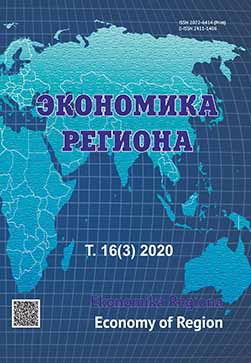Импортозамещение как инструмент стабилизации социально-экономического развития регионов
Import Substitution as a Stabilisation Tool for the Socio-economic Development of Regions
Author(s): Natalya Vasilyevna Krivenko, Daria Sergeevna EpaneshnikovaSubject(s): Economy
Published by: Институт экономики Уральского отделения Российской академии наук
Keywords: region; socio-economic development; industry; industrial policy; sanctions; directions of stabilisation; innovations; assessment of import substitution; dynamic import substitution coefficient
Summary/Abstract: In recent years, the Russian Federation has been actively implementing an import substitution policy. While this particular issue is the topic of various academic studies, there is a lack of research focussing on the quantitative assessment of import substitution. Such an approach allows assessing the effectiveness of the state policy at different levels. Additionally, it provides an opportunity to identify tools for improving the effectiveness of the import substitution. Using examples of Russia and the Ural Federal District (UrFD), the study considers import substitution as an opportunity to stabilise the socio-economic development. We hypothesise that, primarily, the most important competitive advantage of the country is a developed high-tech industry. This assumption requires an immediate activation of import substitution processes and the development of a methodology for assessing its effectiveness. We used the concepts of system economy, sustainable development, innovative development, as well as the methods of comparative, factor, structural analysis, statistical modelling and forecasting methods. Our approach to assessing the effective import substitution includes a developed dynamic import substitution coefficient; its standard value is equal to 1. At the macro-level, this coefficient changes depending on the current import substitution policy. For example, in 2015 — 2016, the coefficient had increased sharply and then decreased below the standard value by 20 %. We have predicted that at the macro-level the dynamic coefficient of import substitution will stabilise after 2019. The example of the Ural Federal District demonstrates that the reverse situation occurs at the meso-level. The calculations show that the region still adheres to the economic model based on the sales of raw materials. The distribution of UrFD enterprises by sales and profitability of operating activities confirms this statement. The largest enterprises in the region (by sales) belong to the oil and gas industry. We propose measures to support industrial policy and production aimed at import substitution. These measures include regulatory, infrastructure, financial, and marketing aspects. The obtained results can be applied in the constituent entities of the Russian Federation.
Journal: Экономика региона
- Issue Year: 16/2020
- Issue No: 3
- Page Range: 765-778
- Page Count: 14
- Language: Russian

